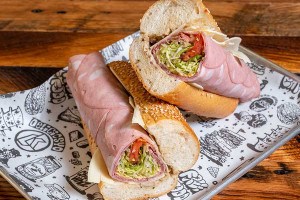Learning Curve: Sate Kampar Reviewed

Photo via Sate Kampar
This is what you do. You go to Sate Kampar on a first date. You save it for someone special—for when Tinder, the phone psychic, your matching Deadpool tattoos or shared fear of dying alone and being eaten by raccoons tells you this is the one. That it’s going to go the distance.
You go to Sate Kampar and you drift down into the hard-backed wooden chairs, under the soft yellow glow of the lights. You order off the sate menu (satay is how you spelled it, always, until seeing it done this other way in a place that probably knows), because meat on sticks? That’s easy. That’s just a little bit foreign but still approachable, good for a first date.
You go for the kambing (the goat) because it’s that kind of night and you’re willing to take chances, and then the ayam (the chicken) for safety.
When they arrive, you strip the nuggets of meat from the skewers with your fork and run them through the bowl of heavily spiced peanut sauce with the slick of oil floating on top, and you taste peanut, of course, cumin and garlic and lemongrass, char from the grill, the dark gaminess of the goat as the fat slicks your tongue. You laugh when you fumble one of the sticks, and then go quiet to watch one of the servers pulling milk tea behind the bar, splashing it back and forth from pot to pot, arms stretched, pale liquid ribboning out like a magic trick. Like a show. You feel warm and happy and cool just for being there—at one of the hottest addresses of the moment, at one of the most sought-after tables—and 30 years from now, on the anniversary of that first date, when Fishtown is a floating neighborhood of artisanal water bars and everyone is, I don’t know, eating lasers or whatever, you can look back and smile and remember the first meal you had at that cute little Malaysian place back when East Passyunk was the hottest neighborhood anywhere in Philly.
This is what you do. You go to Sate Kampar because everyone is going to Sate Kampar. You go because, Jesus, when is the last time we had a Malaysian-Hainanese restaurant open in Philly? And how cool is that? You go because meat on sticks is awesome. Because the staff gets run ragged but never shows it. Because there’s something just charming about the setback entrance and the fact the place opened in an old shoe store. Because that’s so gentrifying-but-in-a-good-way, and something about Sate Kampar makes it seem like it’s already been on the block for years. Like it’s an old favorite. Or at least like it should be.
This is what you do. You go to Sate Kampar by accident, stopping in on a whim and somehow sliding in between the rushes that can still crush the place—cramming it to the artfully distressed brick-under-chipped-plaster walls until everything is just noise and bodies and the dance of servers through the press.
And you do everything wrong. You forget it’s BYO (which is kind of okay, because they’ve got this amazing list of coffee and tea drinks, all illustrated on the back of the menu, plus whole Malayan dwarf coconuts to sip from if you’re feeling daring or just really like coconuts), and you don’t realize that you have to order rice in addition to your entrées because owners John and Angelina Branca (who named the restaurant after her hometown of Kampar in Malaysia) are first-time restaurateurs and even though they’ve done so much right, the whole rice thing isn’t really made clear on their menu. In the end, you order too much because it’s so easy to order too much, and then you have to figure out a way to make the little bowls they give you for portioning out the shareable plates work when there are nine different things on the table.

Skewers at Sate Kampar | Photo via Sate Kampar
But then you go back and you’re better at it. You carry in a six of something lager-ish and ask for a bucket of ice. You restrain yourself and don’t go bonkers with the menu. Five skewers of Hainanese-style pork sate with pineapple-sweetened peanut sauce? That’s more food than it sounds like. And that nasi lemak bungkus is filling—a folded packet of rice wetted down with coconut cream sauce, scattered with roasted peanuts, crisp little arrowheads of anchovy and half a hard-boiled egg, then fired up with a splash of bright red chile sambal. You remember about the rice, and ask for enough sides of fluffy, slightly sweet coconut rice to act as bedding for the beef rendang (which is oily sometimes, a little tough for what’s supposed to be a six-hour braise, and with a texture that sometimes shades in the direction of beef-flavored chewing gum) or the ayam kurma (which is forever awesome—chicken and potatoes in a coconut cream sauce as smooth as curry, but sweeter, and with a bite of coriander). But then you see someone at another table opening the woven banana leaf package of a ketupat rice dumpling and using those sliced chunks of sticky-sweet rice to soak up all that kurma, and you think that’s an even better idea. Which is correct. It is a better idea.
This is what you do. You learn. You walk in one night carrying an Absolut split in your jacket like a straight-up boozer because they’ve got Ribena syrup up on the shelf behind the coffee bar, and a topped shot glass of Ribena is one of those things that just cry out for a hot night, a tall glass of ice and a long pour of Swedish brain tonic. Ribena is a black currant cordial that’s a cultural remnant of the British occupation of Malaysia. By itself, it tastes sickeningly cloying. But water and vodka make it magic, and it pairs so perfectly with the heat of sambal, the char of grilled beef on a stick, the creaminess of the chicken kurma, that you’ll never want to drink anything else.
Sate Kampar has great nights and ones that are merely good. You get used to that. It can take multiple visits to find the coffee or tea drink that’s right for you, because there are 18 options in two different languages, some pulled, some not, some iced, some mixed, one with a lime. The first time you try the sate you’ll say you can taste the flavor of the coconut shell charcoal the kitchen uses in the grill even though really you can’t, because using coconut shell charcoal (which Angelina insisted on using because that’s the way sate is supposed to be grilled) isn’t about adding flavor as much as it’s about taking away the overwhelming smokiness lent by more customary woods. The brunch is strange—essentially a repeat (with some small changes) of everything on the dinner menu except the sate. And yet it seems crazy that Sate Kampar doesn’t just fire up the grills every afternoon and bang out sticks full of meat for the daytime foot traffic on East Passyunk. Pulled coffee and meat sticks? They’d make a killing.
But for now, Sate Kampar is what it is. Not perfect, but fascinating both as a work in progress and as an addition to East Passyunk that (thank God) isn’t another upscale Italian joint or hipper-than-thou gastropub. You can go to Sate Kampar for a lot of reasons, but the best one is just to experience it for yourself—as beautifully imperfect, occasionally mobbed and comfortably weird as it is right now, in this moment. On nights when it’s full to capacity, with customers backed up at the door and all the grills shooting coconut fire, it can feel important in a way that not many new East Passyunk restaurants have lately. And on those nights when the floor isn’t fully committed—when everyone has space to breathe and nothing seems so frantically rushed—it’s one of the most comfortable rooms on the Avenue. A place that makes you want to stay, to hang onto that table for one more cup or one more bite before letting the night end.
2 stars – Come if you’re in the neighborhood.
Sate Kampar [Foobooz]


